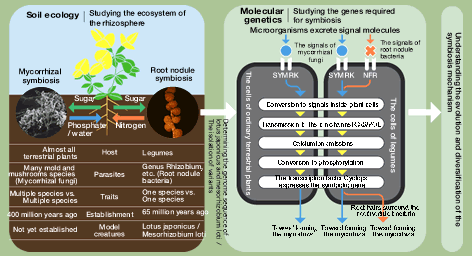Pull up trifolium repens, vicia angustifolia, and other legumes blooming in the fields in the spring and you will find several small lumps. These root nodules are tissues that coexist in the plant’s cells with root nodule bacteria. They supply nitrogen to the plant. At the same time, mycorrhizal fungi in the root tissue wind around the bacterial thread. This provides phosphate and other substances to many plants. This is an important symbiosis for plants.
I selected the lotus japonicus and root nodule bacteria as models and conducted research into the genes required for symbiosis. I unexpectedly discovered several strains of genetic variants that cannot form root nodules, and that mycorrhizal symbiosis was a failure.
The mechanism and role of infection in the mycorrhizal fungi and root nodule bacteria are completely different (refer to the diagram). It seems that the cells of legumes have for a long time cleverly employed the mechanism of a general mycorrhizal symbiosis. This seems to have created a unique root nodule symbiosis with a new host. They also seem to have created a symbiotic genetic network that is well balanced with root nodule bacteria. This masterful arrangement enables us to postulate that it is possible for root nodule bacteria to become minute organs inside the cell like a chloroplast. I want to use the symbiosis of genes as the point of departure for considering their evolution and diversity. |
